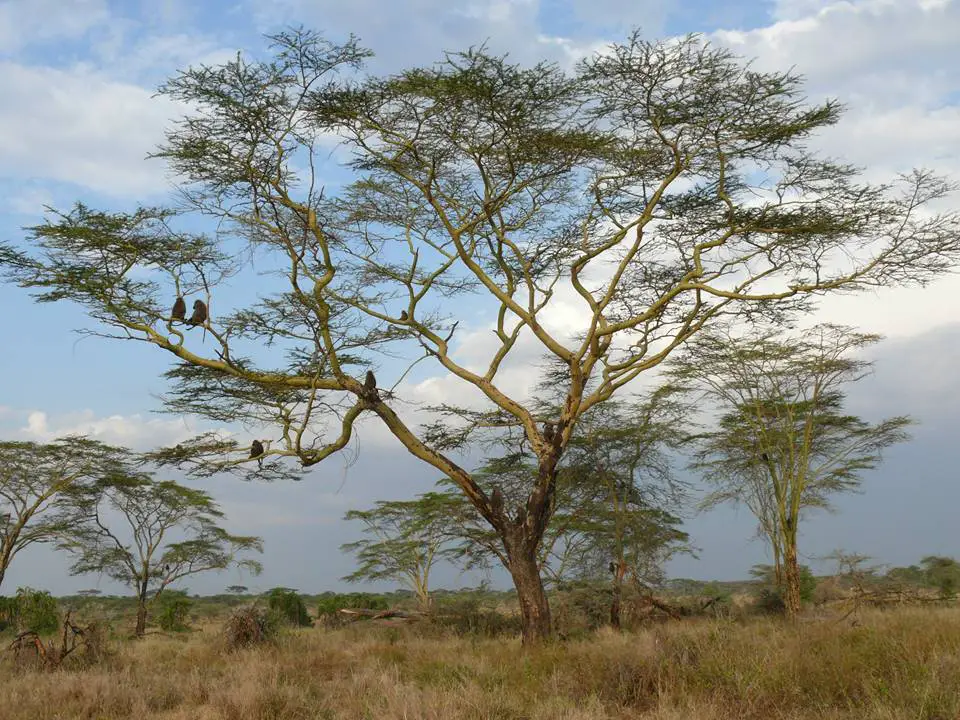The acacia xanthophloea is a type of acacia that can be large as a tree and belongs to the Fabaceae family of plants and is a species that comes from the regions that are to the south and east of the African continent. The name Acacia xanthophloea comes from the ancient Greek language where ACACIA means akis which means tip, which refers to the thorns on its bark in the case of being African since those of Australia do not have and XANTHOPHLOEA where xantho means yellow and pholios means bark, so its name would be something like yellow bark tree with spikes.
Description of the acacia xanthophloea
 The acacia xanthophloea is a type of tree that in ideal conditions can reach heights ranging between 15 meters and 25 meters high, its bark is smooth and yellowish in color with greenish tones, photosynthesis is carried out in this area, unlike of many other trees that perform them through other parts. They have pairs of white thorns that grow at the junctions of the branches. Its leaves are made up of pairs of much smaller leaves from which the flowers are born at the end of each main leaf through round inflorescences of light yellow colors with a very perfumed aroma.
The acacia xanthophloea is a type of tree that in ideal conditions can reach heights ranging between 15 meters and 25 meters high, its bark is smooth and yellowish in color with greenish tones, photosynthesis is carried out in this area, unlike of many other trees that perform them through other parts. They have pairs of white thorns that grow at the junctions of the branches. Its leaves are made up of pairs of much smaller leaves from which the flowers are born at the end of each main leaf through round inflorescences of light yellow colors with a very perfumed aroma.
Distribution of the acacia xanthophloea
 The main area of distribution of the acacia xanthophloea is some countries found on the African continent, such as South Africa and Mozambique, Kenya and Swaziland, Malawi and Zambia, Tanzania and Botswana, in Somalia and also including Zimbabwe. In all these regions the acacia xanthophloea has established itself in such a way that it has become a natural ornament for the regions where it lives and in the same way it has occurred in the urbanized areas where it has been taken.
The main area of distribution of the acacia xanthophloea is some countries found on the African continent, such as South Africa and Mozambique, Kenya and Swaziland, Malawi and Zambia, Tanzania and Botswana, in Somalia and also including Zimbabwe. In all these regions the acacia xanthophloea has established itself in such a way that it has become a natural ornament for the regions where it lives and in the same way it has occurred in the urbanized areas where it has been taken.
Reproduction of the acacia xanthophloea
The acacia xanthophloea reproduces by cultivating its seeds or by replanting the buds, so if it is going to be done from the beginning with the seeds, they must be buried and watered constantly to help their germination, or in their default, you must proceed to remove the plant in the form of a bud from the ground and move it with great care to where it will be transplanted, having previously fertilized this space to later enter it and then add the soil. This plant is resistant to different types of weather but not to strong winters as in the case of the Acacia koa which, like this one, requires regular watering to develop correctly.
In this video we will see a small group of xanthophloealist acacias to be cultivated after working on their reproduction:
Acacia xanthophloea care
The acacia xanthophloea is another of the plants of the acacia genus that needs very little care to obtain a good development, so if you need to think about lighting, it should be said that this plant can be exposed to sunlight without problems, but always regular watering should be considered to keep the soil moist. Despite these few cares, it is important to keep control of their accelerated growth and the easiest way to do this is by pruning their branches and leaves from time to time.
Uses of the acacia xanthophloea
The acacia xanthophloea has different uses that have been used in remote times up to the present, one of them is that since it lives in humid places and is frequented by many mosquitoes, people used its bark and roots as medicine against malaria since it I thought there was a link between the tree and the mosquito disease. Its leaves and legumes have been used to create feed supplements for livestock and bees. The wood is used for firewood and to make a dense black gum similar to that of acacia arabica. Its wood does not crack, due to its hardness and its brown color it is used as a stake for fences.
Other uses of the acacia xanthophloea
The acacia xanthophloea have other uses that could be of an ecological nature or that could be applied to the environment, as is the case of the groves of this acacia can be planted in the vicinity of dikes and dams as well as in farm streams to prevent them from the soil erodes, its foliage provides shade and space for birds to make their nests, it is a natural nitrogen fixer and can be used to decorate gardens, parks, streets and even to create natural fences.

